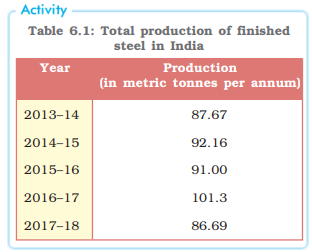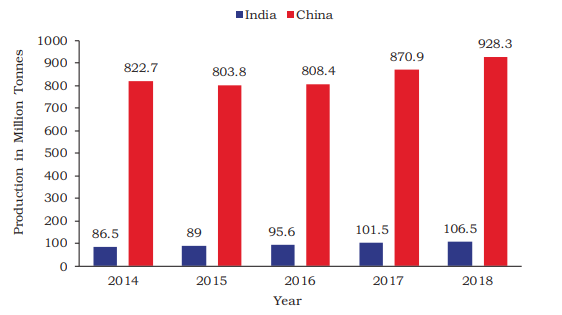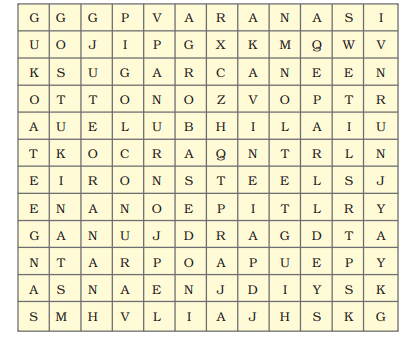Table of Contents
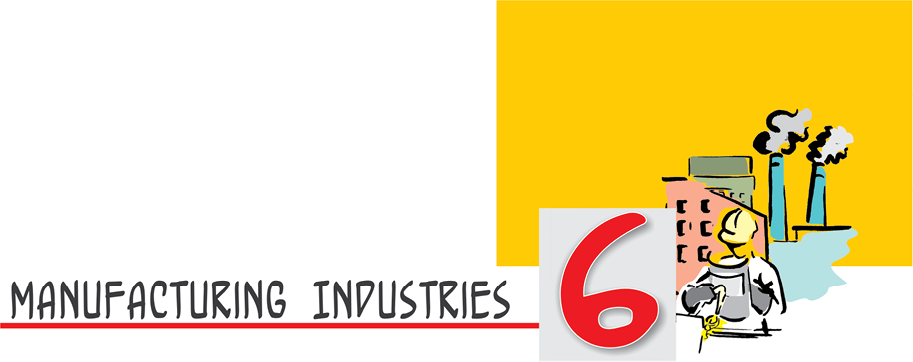

On the occassion of Diwali, Harish went to a market with his parents. They purchased shoes and clothes for him. His mother purchased utensils, sugar, tea and diyas (earthen lamps). Harish observed that the shops in the market were flooded with items for sale. He wondered how so many items could be made in such large quantities. His father explained that shoes, clothes, sugar etc. are manufactured by machines in large industries, some utensils are manufactured in small industries, while items like diyas are made by individual artisans in household industry.
Do you have some ideas about these industries?
Production of goods in large quantities after processing from raw materials to more valuable products is called manufacturing. Do you know that paper is manufactured from wood, sugar from sugarcane, iron and steel from iron ore and aluminium from bauxite? Do you also know that some types of clothes are manufactured from yarn which itself is an industrial product?
People employed in the secondary activities manufacture the primary materials into finished goods. The workers employed in steel factories, car, breweries, textile industries, bakeries etc. fall into this category. Some people are employed in providing services. In this chapter, we are mainly concerned with manufacturing industries which fall in the secondary sector.
The economic strength of a country is measured by the development of manufacturing industries.
Importance of Manufacturing
Manufacturing sector is considered the backbone of development in general and economic development in particular mainly because–
• Manufacturing industries not only help in modernising agriculture, which forms the backbone of our economy, they also reduce the heavy dependence of people on agricultural income by providing them jobs in secondary and tertiary sectors.
• Industrial development is a precondition for eradication of unemployment and poverty from our country. This was the main philosophy behind public sector industries and joint sector ventures in India. It was also aimed at bringing down regional disparities by establishing industries in tribal and backward areas.
• Export of manufactured goods expands trade and commerce, and brings in much needed foreign exchange.
• Countries that transform their raw materials into a wide variety of finished goods of higher value are prosperous. India’s prosperity lies in increasing and diversifying its manufacturing industries as quickly as possible.
Agriculture and industry are not exclusive of each other. They move hand in hand. For instance, the agro-industries in India have given a major boost to agriculture by raising its productivity. They depend on the latter for raw materials and sell their products such as irrigation pumps, fertilisers, insecticides, pesticides, plastic and PVC pipes, machines and tools, etc. to the farmers. Thus, development and competitiveness of manufacturing industry has not only assisted agriculturists in increasing their production but also made the production processes very efficient.
In the present day world of globalisation, our industry needs to be more efficient and competitive. Self-sufficiency alone is not enough. Our manufactured goods must be at par in quality with those in the international market. Only then, will we be able to compete in the international market.
Contribution of Industry to National Economy
Over the last two decades, the share of manufacturing sector has stagnated at 17 per cent of GDP – out of a total of 27 per cent for the industry which includes 10 per cent for mining, quarrying, electricity and gas.
This is much lower in comparison to some East Asian economies, where it is 25 to 35 per cent. The trend of growth rate in manufacturing over the last decade has been around 7 per cent per annum. The desired growth rate over the next decade is 12 per cent. Since 2003, manufacturing is once again growing at the rate of 9 to 10 per cent per annum. With appropriate policy interventions by the government and renewed efforts by the industry to improve productivity, economists predict that manufacturing can achieve its target over the next decade. The National Manufacturing Competitiveness Council (NMCC) has been set up with this objective.
Industrial Location
Industrial locations are complex in nature. These are influenced by availability of raw material, labour, capital, power and market, etc. It is rarely possible to find all these factors available at one place. Consequently, manufacturing activity tends to locate at the most appropriate place where all the factors of industrial location are either available or can be arranged at lower cost. After an industrial activity starts, urbanisation follows. Sometimes, industries are located in or near the cities. Thus, industrialisation and urbanisation go hand in hand. Cities provide markets and also provide services such as banking, insurance, transport, labour, consultants and financial advice, etc. to the industry. Many industries tend to come together to make use of the advantages offered by the urban centres known as agglomeration economies. Gradually, a large industrial agglomeration takes place.
In the pre-Independence period, most manufacturing units were located in places from the point of view of overseas trade such as Mumbai, Kolkata, Chennai, etc. Consequently, there emerged certain pockets of industrially developed urban centres surrounded by a huge agricultural rural hinterland.
Industry – Market Linkage
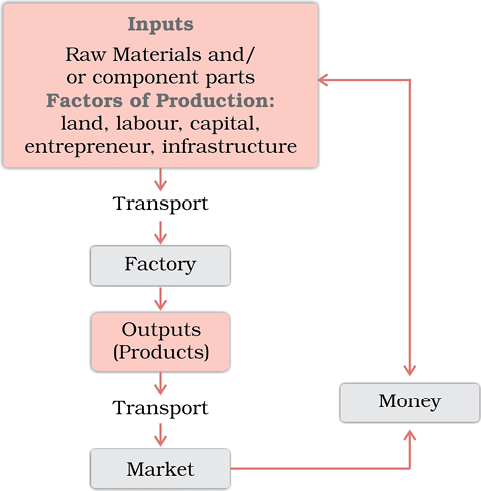
Fig. 6.1
The key to decision of the factory location is the least cost. Government policies and specialised labour also influence the location of industry.

Fig. 6.2
Classification of Industries
List the various manufactured products you use in your daily life such as – transistors, electric bulbs, vegetable oil, cement, glassware, petrol, matches, scooters, automobiles, medicines and so on. If we classify the various industries based on a particular criterion then we would be
able to understand their manufacturing better. Industries may be classified as
follows:
On the basis of source of raw materials used:
• Agro based: cotton, woollen, jute, silk textile, rubber and sugar, tea, coffee, edible oil.
• Mineral based: iron and steel, cement, aluminium, machine tools, petrochemicals.
According to their main role:
• Basic or key industries are those which supply their products as raw materials to manufacture other goods e.g. iron and steel and copper smelting, aluminum smelting.
• Consumer industries that produce goods for direct use by consumers – sugar, toothpaste, paper, sewing machines, fans etc.
On the basis of capital investment:
• A small scale industry is defined with reference to the maximum investment allowed on the assets of a unit. This limit has changed over a period of time. At present the maximum investment allowed is rupees one crore.
On the basis of ownership:
• Public sector, owned and operated by government agencies – BHEL, SAIL etc.
• Private sector industries owned and operated by individuals or a group of individuals –TISCO, Bajaj Auto Ltd., Dabur Industries.
• Joint sector industries which are jointly run by the state and individuals or a group of individuals. Oil India Ltd. (OIL) is jointly owned by public and private sector.
• Cooperative sector industries are owned and operated by the producers or suppliers of raw materials, workers or both. They pool in the resources and share the profits or losses proportionately. Such examples are the sugar industry in Maharashtra, the coir industry in Kerala.
Based on the bulk and weight of raw material and finished goods:
• Heavy industries such as iron and steel
• Light industries that use light raw materials and produce light goods such as electrical goods industries.
Classify the following into two groups on the basis of bulk and weight of raw material and finished goods.
Agro-based Industries
Cotton, jute, silk, woollen textiles, sugar and edible oil, etc. industries are based on agricultural raw materials.

Fig. 6.3: Value addition in the textile industry
Textile Industry: The textile industry occupies unique position in the Indian economy, because it contributes significantly to industrial production, employment generation and foreign exchange earnings. It is the only industry in the country, which is self-reliant and complete in the value chain i.e., from raw material to the highest value added products.
Cotton Textiles: In ancient India, cotton textiles were produced with hand spinning and handloom weaving techniques. After the 18th century, power-looms came into use. Our traditional industries suffered a setback during the colonial period because they could not compete with the mill-made cloth from England.
• The first successful textile mill was established in Mumbai in 1854.
• The two world wars were fought in Europe, India was a British colony. There was a demand for cloth in U.K. hence, they gave a boost to the development of the cotton textile industry.
In the early years, the cotton textile industry was concentrated in the cotton growing belt of Maharashtra and Gujarat. Availability of raw cotton, market, transport including accessible port facilities, labour, moist climate, etc. contributed towards its localisation. This industry has close links with agriculture and provides a living to farmers, cotton boll pluckers and workers engaged in ginning, spinning, weaving, dyeing, designing, packaging, tailoring and sewing. The industry by creating demands supports many other industries, such as, chemicals and dyes, packaging materials and engineering works.
While spinning continues to be centralised in Maharashtra, Gujarat and Tamil Nadu, weaving is highly decentralised to provide scope for incorporating traditional skills and designs of weaving in cotton, silk, zari, embroidery, etc. India has world class production in spinning, but weaving supplies low quality of fabric as it cannot use much of the high quality yarn produced in the country. Weaving is done by handloom, powerloom and in mills.
The handspun khadi provides large scale employment to weavers in their homes as a cottage industry.
Why did Mahatma Gandhi lay emphasis on spinning yarn and weaving khadi?
Why is it important for our country to keep the mill sector loomage lower than power loom and handloom?
India exports yarn to Japan. Other importers of cotton goods from India are U.S.A., U.K., Russia, France, East European countries, Nepal, Singapore, Sri Lanka, and African countries.
We have a large share in the world trade of cotton yarn. Our spinning mills are competitive at the global level and capable of using all the fibres we produce. The weaving, knitting and processing units cannot use much of the high quality yarn that is produced in the country. There are some large and modern factories in these segments, but most of the production is in fragmented small units, which cater to the local market. This mismatch is a major drawback for the industry. As a result, many of our spinners export cotton yarn while apparel/garment manufactures have to import fabric.
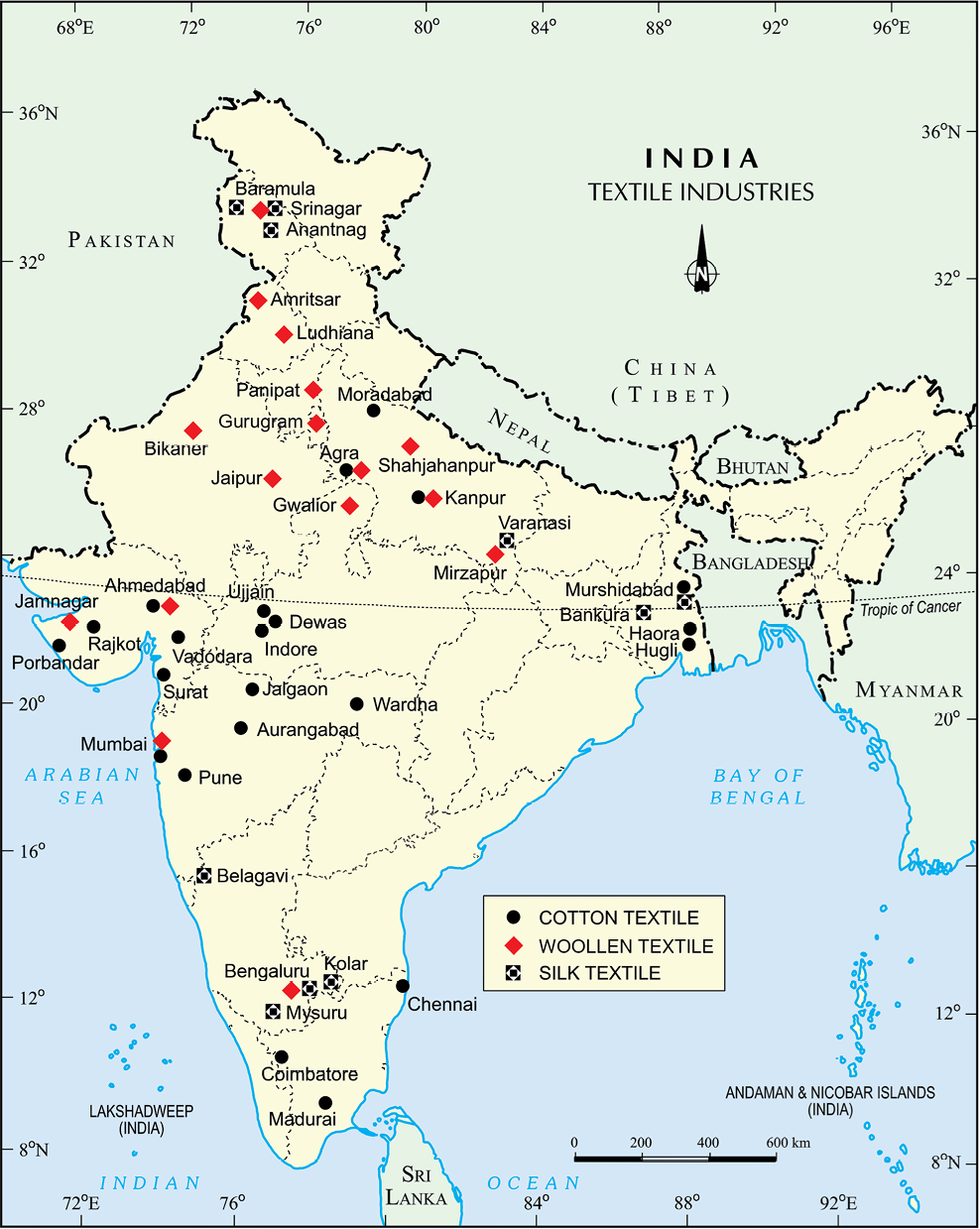
India: Distribution of cotton, woollen and silk industries
Suppose that yarn is sold at Rs. 85 per kg. If it is sold as a trouser it fetches Rs 800 per kg. Value is added at every stage from fibre to yarn to fabric and to garment.
Why is it important for us to improve our weaving sector instead of exporting yarn in large quantities?
Although, we have made significant increase in the production of good quality long staple cotton, the need to import is still felt. Power supply is erratic and machinery needs to be upgraded in the weaving and processing sectors in particular. Other problems are the low output of labour and stiff competition with the synthetic fibre industry.
Jute Textiles
India is the largest producer of raw jute and jute goods and stands at second place as an exporter after Bangladesh. Most of the mills are located in West Bengal, mainly along the banks of the Hugli river, in a narrow belt.
The first jute mill was set up near Kolkata in 1855 at Rishra. After Partition in 1947, the jute mills remained in India but three-fourth of the jute producing area went to Bangladesh (erstwhile East Pakistan).
Factors responsible for their location in the Hugli basin are: proximity of the jute producing areas, inexpensive water transport, supported by a good network of railways, roadways and waterways to facilitate movement of raw material to the mills, abundant water for processing raw jute, cheap labour from West Bengal and adjoining states of Bihar, Odisha and Uttar Pradesh. Kolkata as a large urban centre provides banking, insurance and port facilities for export of jute goods.
Challenges faced by the industry include stiff competition in the international market from synthetic substitutes and from other competitors like Bangladesh, Brazil, Philippines, Egypt and Thailand. However, the internal demand has been on the increase due to the Government policy of mandatory use of jute packaging. To stimulate demand, the products need to be diversified. The main markets are U.S.A., Canada, Ghana, Saudi Arabia, U.K. and Australia. The growing global concern for environment friendly, biodegradable materials, has once again opened the opportunity for jute products.
Sugar Industry
In recent years, there is a tendency for the mills to shift and concentrate in the southern and western states, especially in Maharashtra, This is because the cane produced here has a higher sucrose content. The cooler climate also ensures a longer crushing season. Moreover, the cooperatives are more successful in these states.
Major challenges include the seasonal nature of the industry, old and inefficient methods of production, transport delay in reaching cane to factories and the need to maximise the use of baggase.
Mineral-based Industries
Industries that use minerals and metals as raw materials are called mineral-based industries. Can you name some industries that would fall in this category?
Iron and Steel Industry
The iron and steel industry is the basic industry since all the other industries — heavy, medium and light, depend on it for their machinery. Steel is needed to manufacture a variety of engineering goods, construction material, defence, medical, telephonic, scientific equipment and a variety of consumer goods.
Make a list of all such goods made of steel that you can think of.
Production and consumption of steel is often regarded as the index of a country’s development. Iron and steel is a heavy industry because all the raw materials as well as finished goods are heavy and bulky entailing heavy transportation costs. Iron ore, coking coal and lime stone are required in the ratio of approximately 4 : 2 : 1. Some quantities of manganese, are also required to harden the steel. Where should the steel plants be ideally located? Remember that the finished products also need an efficient transport network for their distribution to the markets and consumers.
In 2018 with 106.5 million tonnes of crude steel production, India ranked 2nd among the world crude steel producers. It is the largest producer of sponge iron. In 2018 per capita consumption of steel in the country was only around 70.9 kg per annum against the world average of 224.5 kg.
Source: Ministry of Steel, Government of India
Why is the per capita consumption of steel so low in India?
Collect information about products of steel plants in India.
Mini steel plants are smaller, have electric furnaces, use steel scrap and sponge iron. They have re-rollers that use steel ingots as well. They produce mild and alloy steel of given specifications.

Fig. 6.4

India: Iron and Steel Plants
An integrated steel plant is large, handles everything in one complex – from putting together raw material to steel making, rolling and shaping.
Most of the public sector undertakings market their steel through Steel Authority of India Ltd. (SAIL).
In the 1950s China and India produced almost the same quantity of steel. Today, China is the largest producer of steel. China is also the world’s largest consumer of steel.
Chhotanagpur plateau region has the maximum concentration of iron and steel industries. It is largely, because of the relative advantages this region has for the development of this industry. These include, low cost of iron ore, high grade raw materials in proximity, cheap labour and vast growth potential in the home market. Though, India is an important iron and steel producing country in the world yet, we are not able to perform to our full potential largely due to: (a) High costs and limited availability of coking coal (b) Lower productivity of labour (c) Irregular supply of energy and (d) Poor infrastructure.
We also import good quality steel from other countries. However, the overall production of steel is sufficient to meet our domestic demand.
Liberalisation and Foreign Direct Investment have given a boost to the industry with the efforts of private entrepreneurs. There is a need to allocate resources for research and development to produce steel more competitively.
Have you read about the Kalinganagar controversy? Collect information from different sources and discuss.
Aluminium Smelting
Aluminium smelting is the second most important metallurgical industry in India. It is light, resistant to corrosion, a good conductor of heat, malleable and becomes strong when it is mixed with other metals. It is used to manufacture aircraft, utensils and wires. It has gained popularity as a substitute of steel, copper, zinc and lead in a number of industries.
Fig. 6.5: Crude Steel Production in India and China
Source: World Steel Association, website: www.worldsteel.org
Aluminium smelting plants in the country are located in Odisha, West Bengal, Kerala, Uttar Pradesh, Chhattisgarh, Maharashtra and Tamil Nadu.
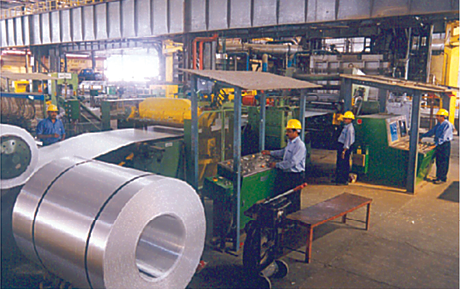
Fig. 6.6: Strip coasting mill at smelter of NALCO
Bauxite, the raw material used in the smelters is a very bulky, dark reddish coloured rock. The flow chart given below shows the process of manufacturing aluminium. Regular supply of electricity and an assured source of raw material at minimum cost are the two prime factors for location of the industry.
A factory produces aluminium saucepans with plastic handles. It obtains aluminium from a smelter and a plastic component from another factory. All the manufactured saucepans are sent to a warehouse:
1. (a) Which raw material is likely to be most expensive to transport and why?
(b) Which raw material is likely to be the cheapest to transport and why?
2. Do you think the cost of transporting the finished products after packaging is likely to be cheaper or more expensive than the cost of transporting aluminium and plastic? Why?
Chemical Industries

Fig. 6.7
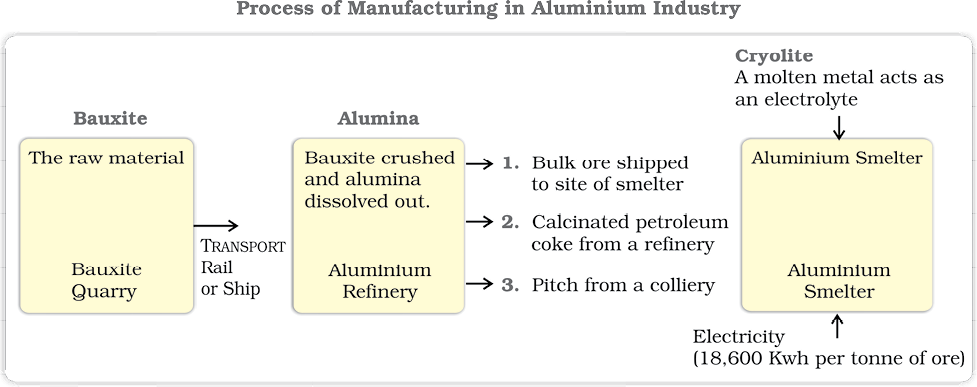
Fig. 6.8
Why do you think it is so?
Organic chemicals include petrochemicals, which are used for manufacturing of synthetic fibers, synthetic rubber, plastics, dye-stuffs, drugs and pharmaceuticals. Organic chemical plants are located near oil refineries or petrochemical plants.
The chemical industry is its own largest consumer. Basic chemicals undergo processing to further produce other chemicals that are used for industrial application, agriculture or directly for consumer markets. Make a list of the products you are aware of.
Fertilizer Industry
The fertilizer industry is centred around the production of nitrogenous fertilizers (mainly urea), phosphatic fertilizers and ammonium phosphate (DAP) and complex fertilizers which have a combination of nitrogen (N), phosphate (P), and potash (K). The third, i.e. potash is entirely imported as the country does not have any reserves of commercially usable potash or potassium compounds in any form.
After the Green Revolution the industry expanded to several other parts of the country. Gujarat, Tamil Nadu, Uttar Pradesh, Punjab and Kerala contribute towards half of the fertilizer production. Other significant producers are Andhra Pradesh, Odisha, Rajasthan, Bihar, Maharashtra, Assam, West Bengal, Goa, Delhi, Madhya Pradesh and Karnataka.
Cement Industry
Cement is essential for construction activity such as building houses, factories, bridges, roads, airports, dams and for other commercial establishments. This industry requires bulky and heavy raw materials like limestone, silica and gypsum. Coal and electric power are needed apart from rail transportation.
Where would it be economically viable to set up the cement manufacturing units?
The industry has strategically located plants in Gujarat that have suitable access to the market in the Gulf countries.
Find out where the plants are located in other States of India. Find their names.
The first cement plant was set up in Chennai in 1904. After Independence the industry expanded.
Improvement in the quality has found the produce a readily available market in East Asia, Middle East, Africa and South Asia apart from a large demand within the country. This industry is doing well in terms of production as well as export. Efforts are being made to generate adequate domestic demand and supply in order to sustain this industry.
Automobile Industry
Automobiles provide vehicle for quick transport of good services and passengers. Trucks, buses, cars, motor cycles, scooters, three-wheelers and multi-utility vehicles ae manufactured in India at various centres. After the liberalisation, the coming in of new and contemporary models stimulated the demand for vehicles in the market, which led to the healthy growth of the industry including passenger cars, two and three-wheelers. The industry is located around Delhi, Gurugram, Mumbai, Pune, Chennai, Kolkata, Lucknow, Indore, Hyderabad, Jamshedpur and Bengaluru.
Information Technology and Electronics Industry
The electronics industry covers a wide range of products from transistor sets to television, telephones, cellular telecom, telephone exchange, radars, computers and many
other equipments required by the telecommunication industry. Bengaluru has emerged as the electronic capital of India. Other important centres for electronic goods are Mumbai, Delhi, Hyderabad, Pune, Chennai, Kolkata, Lucknow and Coimbatore. The major industry concentration is at Bengaluru, Noida, Mumbai, Chennai, Hyderabad and Pune. A major impact of this industry has been on employment generation. The continuing growth in the hardware and software is the key to the success of IT industry in India.
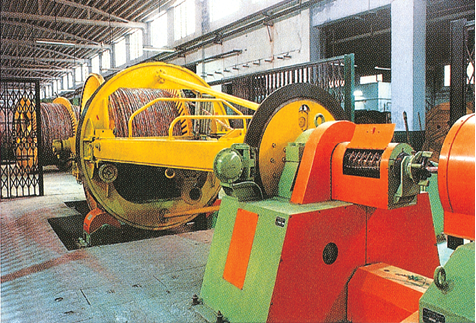
Fig. 6.9: Cable manufacturing facilities at HCL, Rupnarainpur (West Bengal)
Industrial Pollution and Environmental Degradation
Although industries contribute significantly to India’s economic growth and development, the increase in pollution of land, water, air, noise and resulting degradation of environment that they have caused, cannot be overlooked. Industries are responsible for four types of pollution: (a) Air (b) Water (c) Land (d) Noise. The polluting industries also include thermal power plants.
Air pollution is caused by the presence of high proportion of undesirable gases, such as sulphur dioxide and carbon monoxide. Air-borne particulate materials contain both solid and liquid particles like dust, sprays mist and smoke. Smoke is emitted by chemical and paper factories, brick kilns, refineries and smelting plants, and burning of fossil fuels in big and small factories that ignore pollution norms. Toxic gas leaks can be very hazardous with long-term effects. Are you aware of the Bhopal Gas tragedy that occurred? Air pollution adversely affects human health, animals, plants, buildings and the atmosphere as a whole.
Water pollution is caused by organic and inorganic industrial wastes and affluents discharged into rivers. The main culprits in this regard are paper, pulp, chemical, textile and dyeing, petroleum refineries, tanneries and electroplating industries that let out dyes, detergents, acids, salts and heavy metals like lead and mercury pesticides, fertilisers, synthetic chemicals with carbon, plastics and rubber, etc. into the water bodies. Fly ash, phospo- gypsum and iron and steel slags are the major solid wastes in India.
Thermal pollution of water occurs when hot water from factories and thermal plants is drained into rivers and ponds before cooling. What would be the effect on aquatic life?
Wastes from nuclear power plants, nuclear and weapon production facilities cause cancers, birth defects and miscarriages. Soil and water pollution are closely related. Dumping of wastes specially glass, harmful chemicals, industrial effluents, packaging, salts and garbage renders the soil useless. Rain water percolates to the soil carrying the pollutants to the ground and the ground water also gets contaminated.
Noise pollution not only results in irritation and anger, it can also cause hearing impairment, increased heart rate and blood pressure among other physiological effects. Unwanted sound is an irritant and a source of stress. Industrial and construction activities, machinery, factory equipment, generators, saws and pneumatic and electric drills also make a lot of noise.
Control of Environmental Degradation
Every litre of waste water discharged by our industry pollutes eight times the quantity of freshwater. How can the industrial pollution of fresh water be reduced? Some suggestions are-
(i) minimising use water for processing by reusing and recycling it in two or more successive stages
(ii) harvesting of rainwater to meet water requirements
(iii) treating hot water and effluents before releasing them in rivers and ponds. Treatment of industrial effluents can be done in three phases
(a) Primary treatment by mechanical means. This involves screening, grinding, flocculation and sedimentation.
(b) Secondary treatment by biological process
(c) Tertiary treatment by biological, chemical and physical processes. This involves recycling of wastewater.
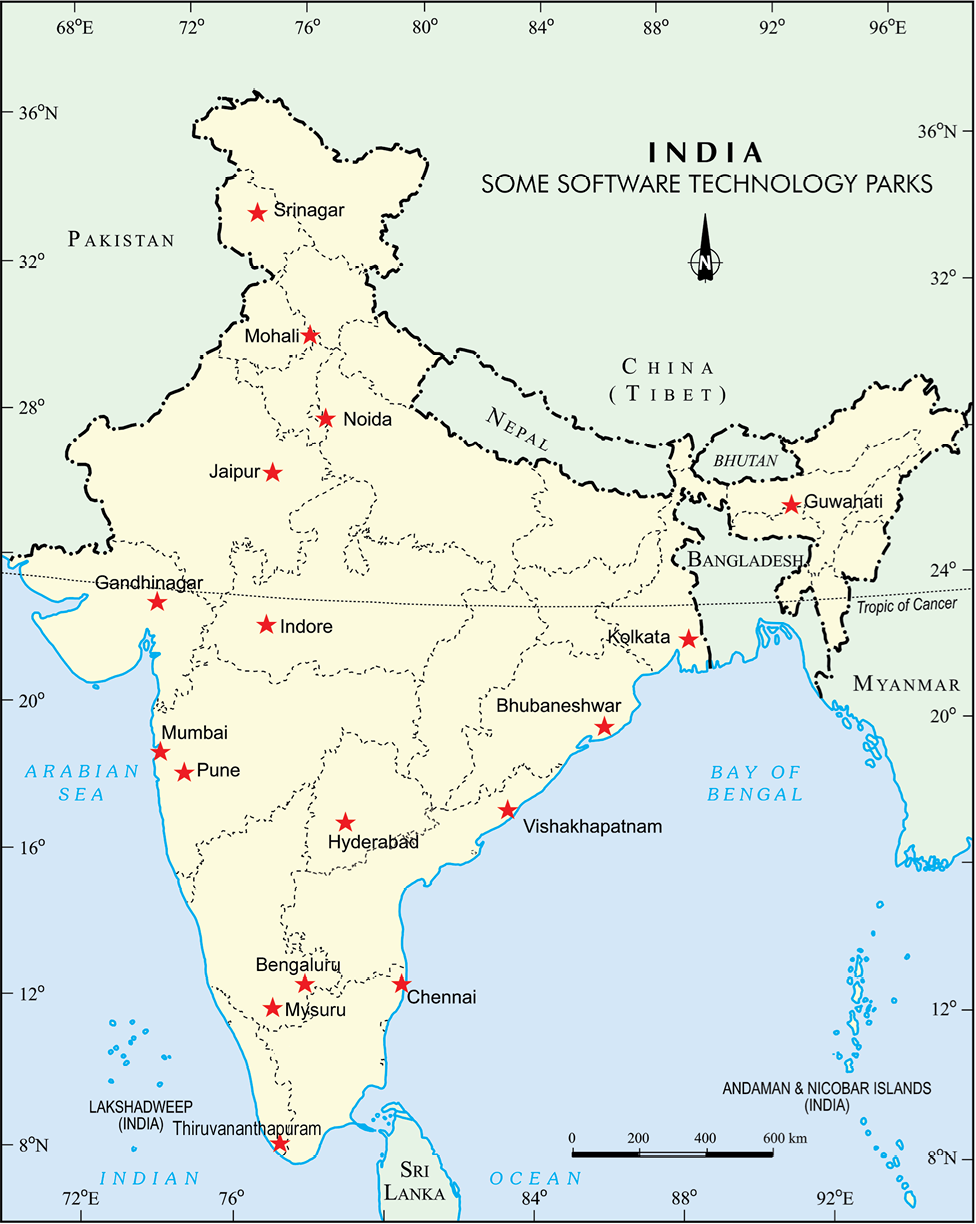
India: Some Software Technology Parks
Overdrawing of ground water reserves by industry where there is a threat to ground water resources also needs to be regulated legally. Particulate matter in the air can be reduced by fitting smoke stacks to factories with electrostatic precipitators, fabric filters, scrubbers and inertial separators. Smoke can be reduced by using oil or gas instead of coal in factories. Machinery and equipment can be used and generators should be fitted with silencers. Almost all machinery can be redesigned to increase energy efficiency and reduce noise. Noise absorbing material may be used apart from personal use of earplugs and earphones.
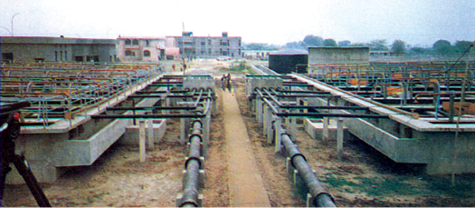
Fig. 6.10: Sewage Treatment plant under Yamuna action plan at Faridabad
The challenge of sustainable development requires integration of economic development with environmental concerns.
NTPC shows the way
NTPC is a major power providing corporation in India. It has ISO certification for EMS (Environment Management System) 14001. The corporation has a proactive approach for preserving the natural environment and resources like water, oil and gas and fuels in places where it is setting up power plants. This has been possible through-
(a) Optimum utilisation of equipment adopting latest techniques and upgrading existing equipment.
(b) Minimising waste generation by maximising ash utilisation.
(c) Providing green belts for nurturing ecological balance and addressing the question of special purpose vehicles for afforestation.
(d) Reducing environmental pollution through ash pond management, ash water recycling system and liquid waste management.
(e) Ecological monitoring, reviews and on-line database management for all its power stations.
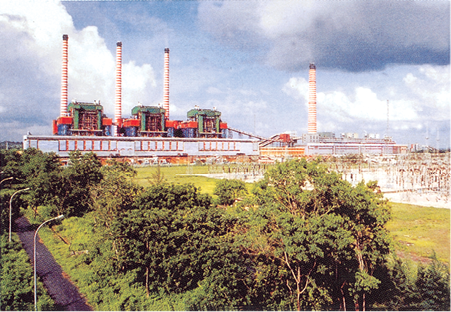
Exercises Exercises Exercises Exercises Exercises
1. Multiple choice questions.
(i) Which one of the following industries uses limestone as a raw material.
(a) Aluminium (b) Cement (c) Plastic (d) Automobile
(ii) Which one of the following agencies markets steel for the public sector plants?
(a) HAIL (b) SAIL (c) TATA Steel (d) MNCC
(iii) Which one of the following industries uses bauxite as a raw material?
(a) Aluminium Smelting (b) Cement (c) Paper (d) Steel
(iv) Which one of the following industries manufactures telephones, computer, etc.
(a) Steel (c) Aluminium Smelting
(b) Electronic (d) Information Technology
2. Answer the following briefly in not more than 30 words.
(i) What is manufacturing?
(ii) Name any three physical factors for the location of the industry.
(iii) Name any three human factors for the location of an industry.
(iv) What are basic industries? Give an example.
(v) Name the important raw materials used in the manufacturing of cement?
3. Write the answers of the following questions in 120 words.
(i) How are integrated steel plants different from mini steel plants? What problems does the industry face? What recent developments have led to a rise in the production capacity?
(ii) How do industries pollute the environment?
(iii) Discuss the steps to be taken to minimise environmental degradation by industry?
Activity
Give one word for each of the following with regard to industry. The number of letters in each word are hinted in brackets.
(i) Used to drive machinery (5) P...........................
(ii) People who work in a factory (6) W..........................
(iii) Where the product is sold (6) M..........................
(iv) A person who sells goods (8) R...........................
(v) Thing produced (7) P...........................
(vi) To make or produce (11) M..........................
(vii) Land, Water and Air degraded (9) P...........................
Project Work
Select one agro-based and one mineral-based industry in your area.
(i) What are the raw materials they use?
(ii) What are the other inputs in the process of manufacturing that involve transportation cost?
(iii) Are these factories following environmental norms?
Activity
Solve the puzzle by following your search horizontally and vertically to find the hidden answers.
1. Textiles, sugar, vegetable oil and plantation industries deriving raw materials from agriculture are called…
2. The basic raw material for sugar industry.
4. Iron-ore, coking coal, and limestone are the chief raw materials of this industry.
5. A public sector steel plant located in Chhattisgarh.
6. Railway diesel engines are manufactured in Uttar Pradesh at this place.
